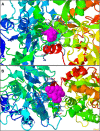Hypothesis: apo-lactoferrin-Galantamine Proteo-alkaloid Conjugate for Alzheimer's disease Intervention
- PMID: 29377514
- PMCID: PMC5824407
- DOI: 10.1111/jcmm.13484
Hypothesis: apo-lactoferrin-Galantamine Proteo-alkaloid Conjugate for Alzheimer's disease Intervention
Abstract
Alzheimer's disease (AD) is known to be caused by the accumulation of deformed beta amyloid and hyperphosphorylated tau proteins resulting into formation and aggregation of senile plaques and neurofibrillary tangles in the brain. Additionally, AD is associated with the accumulation of iron or metal ions in the brain which causes oxidative stress. Galantamine (Gal) is one of the therapeutic agents that has been approved for the treatment of AD, but still saddled with numerous side effects and could not address the issue of iron accumulation in the brain. The use of metal chelators to address the iron accumulation has not been successful due to toxicity and inability to address the aggregation of the plaques. We therefore hypothesize a combinatorial antioxidant-metal-chelator approach by formulating a single dosage form that has the ability to prevent the formation of free radicals, plaques and accumulation of iron in the brain. This can be achieved by conjugating Gal with apo-lactoferrin (ApoLf), a natural compound that has high binding affinity for iron, to form an apo-lactoferrin-galantamine proteo-alkaloid conjugate (ApoLf-Gal) as a single dosage form for AD management. The conjugation is achieved through self-assembly of ApoLf which results in encapsulation of Gal. ApoLf changes its conformational structure in the presence of iron; therefore, ApoLf-Gal is proposed to deliver Gal and pick up excess iron when in contact with iron. This strategy has the potential to proffer a dual neuroprotection and neurotherapeutic interventions for the management of AD.
Keywords: Alzheimer's disease; antioxidant; apo-lactoferrin; free radical; galantamine; metal chelation; proteo-alkaloid.
© 2018 The Authors. Journal of Cellular and Molecular Medicine published by John Wiley & Sons Ltd and Foundation for Cellular and Molecular Medicine.
Figures




References
-
- Tsai LH, Madabhushi R. Alzheimer's disease: a protective factor for the ageing brain. Nature. 2014; 507: 439–40. - PubMed
-
- Alzheimer's Association . 2012 Alzheimer's disease facts and figures. Alzheimers Dement 2012; 8: 131–68. - PubMed
-
- Bäckman L, Jones S, Berger AK, et al Multiple cognitive deficits during the transition to Alzheimer's disease. J Intern Med. 2004; 256: 195–204. - PubMed
-
- Arnáiz E, Almkvist O. Neuropsychological features of mild cognitive impairment and preclinical Alzheimer's disease. Acta Neurol Scand. 2003; 107: 34–41. - PubMed
Publication types
MeSH terms
Substances
LinkOut - more resources
Full Text Sources
Other Literature Sources
Medical
Miscellaneous

